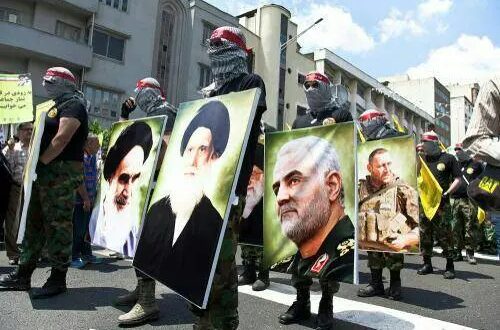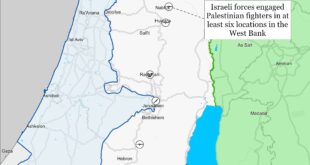Abstract: The spectre of a U.S.-Iran war is haunting the world. However, it is still less likely than many think. For its part, Tehran is aware that it lacks the military capabilities and financial resources to endure a direct military confrontation with the United States. Engaging in a full-scale war with Iran would also be catastrophic for the U.S. At a time when there is a need to focus on the competition with Russia and the People’s Republic of China (PRC), a direct war with Iran would reduce Washington’s capacity to counter revisionist states’ subversive activities. As such, ‘hybrid warfare’ still fits better into both sides’ cost-benefit calculus.
Problem statement: Are the U.S. and Iran headed toward full-scale war?
So what?: While the Russia-Ukraine war has demonstrated that hybrid conflict is not the sole model of warfare, it remains rare for states to engage in conventional warfare. As such, it is advisable for states to prioritise hybrid warfare activities in determining their security strategies for the foreseeable future without underestimating the risks associated with conventional warfare.
The Spectre of War
The spectre of a U.S.-Iran war is haunting the world.[1] Recent events have sparked widespread concerns that the ongoing ‘hybrid war’, a type of conflict that falls somewhere between war and peace, may escalate into a full-fledged war between the two countries. Both Washington and Tehran say they do not want a war.[2] However, with each tit-for-tat exchange and retaliatory strike, the conflict edges closer to the brink, where the spectre of a full-scale war becomes ever more palpable.
Thomas Shannon, former Undersecretary of State for Political Affairs, for example, said in February 2024 that “the U.S. is in danger of slow-walking itself into a war with Iran.”[3] Secretary of State Antony Blinken seemed to agree with such an assessment when he stated that “we’ve not seen a situation as dangerous as the one we’re facing now across the region since at least 1973, and arguably even before that.”[4]
The U.S. is in danger of slow-walking itself into a war with Iran.Indeed, hybrid conflicts have the potential to escalate into an outright military confrontation, as has been the case in the Russian-Ukrainian War. Thus, no one can ignore the risk that the hybrid war between the U.S. and Iran can lead to an all-out war. However, a full-blown U.S.-Iran war is still less likely than many think.
For its part, Tehran is aware that it lacks the military capabilities and financial resources to endure a direct military confrontation with the U.S. Furthermore, Iran’s leadership prioritises the preservation of its regime. It is averse to the prospect of engaging in a costly war with the U.S., recognising the huge economic and human toll such a war would cause. Instead, the Iranian regime engages in proxy warfare operations against the U.S. across the Middle East for various reasons, including avoiding the costs of open warfare, maintaining plausible deniability, leveraging the local knowledge of proxy combatants, and compensating for its military and economic deficiencies. The major concerns with regard to a war with Iran revolve around the fact that some of the actions of Iran’s proxy fighters in Iraq, Syria, Lebanon, and Yemen might increase the risk of escalation despite Tehran’s desire to avoid a war.[5] Yet, Tehran currently exercises considerable influence over its proxy groups, such as Hezbollah, Houthis, and Hashd al-Shaabi, by maintaining control over their arsenal, financing, and fostering substantial political ties with their top leaders, thereby enabling the modulation of their behaviour as necessary.[6]
Engaging in a full-scale war with Iran would also be catastrophic for the U.S.[7] Over the past several years, renewed great power rivalry with Russia and the PRC has become the crux of the U.S. security agenda.[8] Undoubtedly, Iran is another important security concern for Washington in today’s complex security environment. A Congressional Research Service (CRS) Report declares, “Three main sets of challengers- the revisionist powers of China and Russia, the rogue states of Iran and North Korea, and transnational threat organisations, particularly jihadist terrorist groups, are actively competing against the United States.”[9] It appears that Iran is classified as a Tier 2 priority on the U.S. list. At a time when there is a need to focus on the competition with Russia and the PRC, a direct war with Iran would reduce Washington’s capacity to counter revisionist states’ aggressive foreign policy behaviours. More precisely, if the U.S. engage in large-scale combat operations against Iran, it may not be able to provide sufficient support to Ukraine under Russian occupation and deter the PRC from invading Taiwan.
Endless Wars
In addition, the U.S. has grown weary of ‘endless wars’ in the Middle East. The U.S. wasted trillions of dollars in post-9/11 wars.[10] The prolonged wars in Afghanistan and Iraq have drastically harmed America’s image abroad. The human toll was also profound. Therefore, Washington has hesitated to become involved in another costly Middle East war.
Above all, although Washington has long sought to weaken, or even destroy, the Iranian regime, it does not perceive an existential threat from Iran at present. When the interests at stake are significant but not existential, defeating the enemy through large-scale combat operations would not be necessary. Washington’s threat perceptions regarding the Iranian regime would undoubtedly intensify if Iran were to launch an attack on Israel or directly target the U.S. rather than using its proxy combatants. However, this is not the case today for the Iranian state.
Although Washington has long sought to weaken, or even destroy, the Iranian regime, it does not perceive an existential threat from Iran at present.Besides, invading Iran would present significant military challenges due to operational disadvantages akin to those encountered in Afghanistan. Much of Iran’s terrain is characterised by rugged mountains and vast barren deserts, which hinder large-scale military operations and diminish the likelihood of success in a military invasion. Therefore, Iran’s greatest defence lies in its geography. Moreover, Tehran could launch a protracted insurgency campaign against U.S. forces, echoing past experiences in Afghanistan and Iraq. Iran possesses skilled paramilitary groups like the Quds Force of the Iranian Revolutionary Guard and supports an extensive network of armed groups across the Middle East. Iran might also reorganise its regular military forces into irregular formations, similar to the Iraqi Fedayeen’s actions in 2003.[11] Additionally, amphibious assaults, one of the most complex military operations, could be jeopardised by Iran’s capability to wage guerrilla warfare at sea.[12]
As such, hybrid warfare activities still fit better into both sides’ cost-benefit calculus. The U.S.-Iran hybrid war is actually not a recent phenomenon.[13] For decades, Washington and Tehran have waged a hybrid war across the Middle East. Tehran has a lengthy history of employing hybrid warfare tactics against the United States, dating back to the establishment of the Islamic Republic during the 1979 revolution. These tactics, including proxy warfare, covert paramilitary operations, propaganda, and cyber-attacks, have been utilised as part of Iran’s strategic efforts to consolidate its regime, assert influence within areas it considers belonging to an Iranian/Shia sphere of influence, and counter perceived American interests. In response, the United States has deployed a range of measures, including diplomatic pressure, military posturing, targeted assassinations, and economic sanctions, aimed at curtailing Iran’s activities and protecting its own interests in the Middle East.[14] The main thing is that today, the U.S.-Iran hybrid conflict has become much more violent than in the past. Hamas’s deadly October 07, 2023, attack and Israel’s tough response have been the most important turning points for this prolonged conflict. Starting on October 18, 2023, and in reaction to Washington’s staunch support for Israel in its military operations in Gaza, Iran-aligned militia groups carried out a series of more than 160 attacks on U.S. military installations in Syria, Iraq, and Jordan.[15]
The U.S.-Iran hybrid conflict has become much more violent than in the past. Hamas’s deadly October 07, 2023, attack and Israel’s tough response have been the most important turning points for this prolonged conflict.In response, the U.S. forces have launched airstrikes against dozens of targets linked to Iran’s Revolutionary Guard (IRGC) in Syria and Iraq.[16] The U.S. drone strike that killed Abu Baqir al-Saadi, a leader in the Iran-backed Kataib Hezbollah, on February 07, 2024, is the latest move in the hybrid war between Tehran and Washington, which has been fought with varying degrees of intensity for over four decades.[17]
No one knows how long the U.S.-Iran hybrid war will last. However, one can expect that it will continue to escalate. As tensions continue to simmer and both sides engage in a dangerous game of brinkmanship, the likelihood of further escalation in hybrid warfare activities looms ominously on the horizon. In this volatile strategic landscape, the path to de-escalation seems elusive, as entrenched animosities and competing security interests perpetuate a cycle of violence and retaliation.
Strategic Ambiguity
Hybrid warfare tactics continue to align more closely with the cost-benefit calculations of both sides, reducing the likelihood of a full-scale U.S.-Iran conflict. While this presents a positive aspect in terms of potentially minimising the overall devastation for both nations and the global community compared to open warfare, it also carries the downside of exacerbating instability in the Middle East due to the ongoing tit-for-tat strikes and skirmishes.
Hybrid warfare tactics continue to align more closely with the cost-benefit calculations of both sides, reducing the likelihood of a full-scale U.S.-Iran conflict. Eurasia Press & News
Eurasia Press & News




